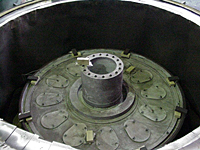Nitriding
(click on thumbnail to enlarge) 
Nitriding
Large gear for an industrial application nitrided to a 0.040" case depth. Gear measures 12' in diameter by 12' tall and weighs approximately 24,000 pounds. Gear hub, bore and web faces have been masked to prevent nitriding to allow for post heat treatment machining.
Nitriding | Facilities

Nitriding
Gas nitriding is a surface hardening process, where nitrogen is added to the surface of steel parts using dissociated ammonia as the source. Gas nitriding develops a very hard case in a component at relatively low temperature, without the need for quenching.
Nitriding is carried out at temperatures below the transformation temperature of alloy steels, so that with proper manufacturing techniques, there is little or no distortion as a result of the process. Parts to be nitrided are heat treated to the proper strength level, and final machined. The parts are then exposed to active nitrogen at a carefully controlled temperature, typically in the range of 925°F to 985°F. This temperature is typically below the final tempering temperature of the steel so that nitriding does not affect the base metal mechanical properties. As a result, a very high strength product with extremely good wear resistance can be produced, with little or no dimensional change.
The components to be nitrided are often stress relieved prior to final machining so that the only size changes observed are growth of about 0.0005". In some cases, nitrided components are surface ground after nitriding to remove the most outermost brittle layer produced by the process, or to bring parts into a tight tolerance.
Parts can be masked avoid hardening some areas, such as gear hubs and bores, keyways, threaded holes or bearing surfaces, which are easily machined after nitriding. Typical hardness for different nitrided steels is shown in the table below:
| Steel |
Core Hardness HRC |
Surface Hardness HRC |
Case Depth |
| 1020,1045, Cast Iron |
14-18 |
File Hard |
0.002 - 0.010 |
| 4130, 4140 |
28-32 |
52-58 |
0.008 - 0.024 |
| 4340 |
28-32 |
49-55 |
0.008 - 0.024 |
| Nitralloy 135M |
28-36 |
67-71 |
0.008 - 0.020 |
| P20 |
28-36 |
57-62 |
0.008 - 0.020 |
| A2, D-2 |
54-60 |
65-70 |
0.005 - 0.010 |
| H13, S7 |
45-50 |
67-71 |
0.004 - 0.012 |
| M2, M-4, M42 |
60-65 |
69-72 |
0.0005-0.002 |
| 304, 316 SST. |
0 (HRB 80) |
62-66 |
0.0 |
Facilities
Gas Nitriding/Nitrocarburizing (900° - 1200°F)
Maximum Load Sizes
- Pit Furnace - 144" Diameter by 96" High
- Pit Furnace - 180" Diameter by 144" High
- Pit Furnace - 22" Diameter by 36" High
|
- Bell Furnaces (4) - 72" Diameter by 80" High
- Pit Furnace - 28" Diameter by 252" High
|

|






 Print This Page
Print This Page

